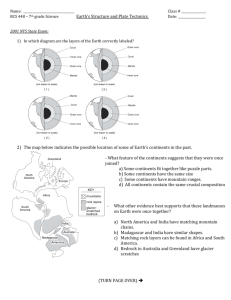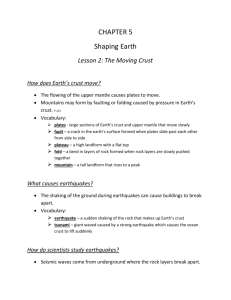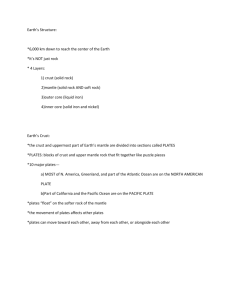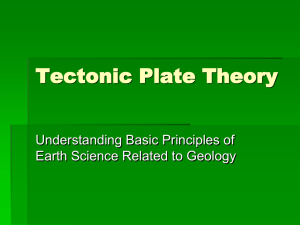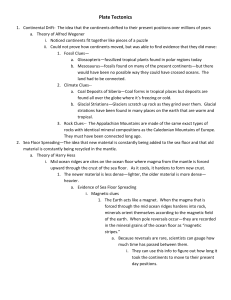File
advertisement
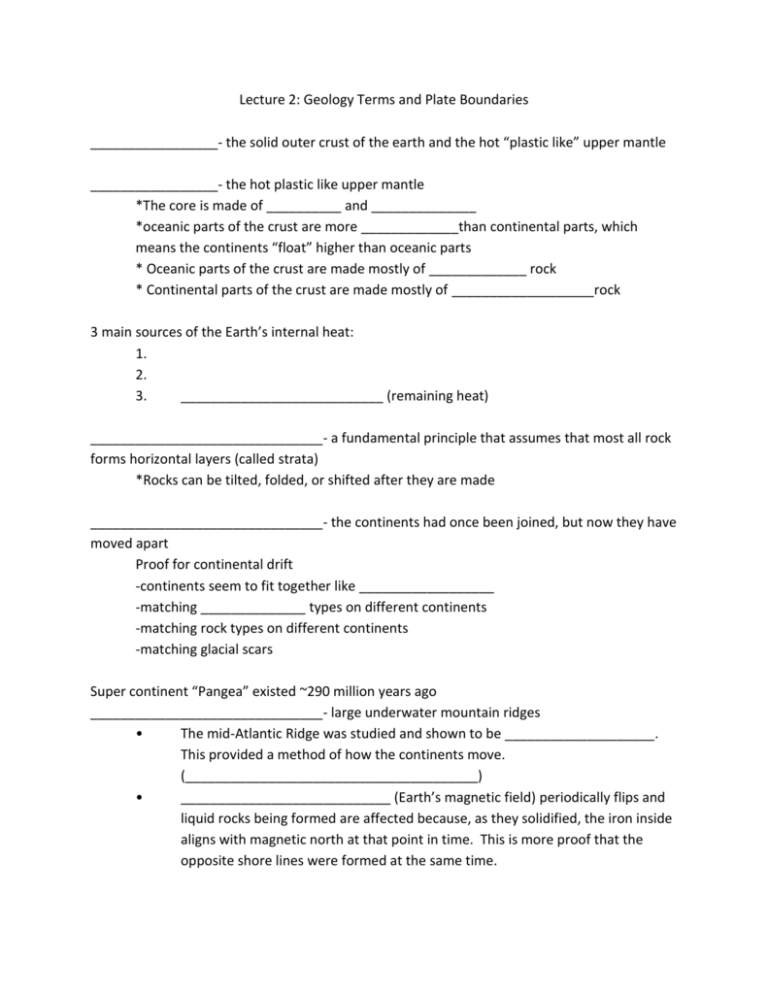
Lecture 2: Geology Terms and Plate Boundaries _________________- the solid outer crust of the earth and the hot “plastic like” upper mantle _________________- the hot plastic like upper mantle *The core is made of __________ and ______________ *oceanic parts of the crust are more _____________than continental parts, which means the continents “float” higher than oceanic parts * Oceanic parts of the crust are made mostly of _____________ rock * Continental parts of the crust are made mostly of ___________________rock 3 main sources of the Earth’s internal heat: 1. 2. 3. ___________________________ (remaining heat) _______________________________- a fundamental principle that assumes that most all rock forms horizontal layers (called strata) *Rocks can be tilted, folded, or shifted after they are made _______________________________- the continents had once been joined, but now they have moved apart Proof for continental drift -continents seem to fit together like __________________ -matching ______________ types on different continents -matching rock types on different continents -matching glacial scars Super continent “Pangea” existed ~290 million years ago _______________________________- large underwater mountain ridges • The mid-Atlantic Ridge was studied and shown to be ____________________. This provided a method of how the continents move. (_______________________________________) • ____________________________ (Earth’s magnetic field) periodically flips and liquid rocks being formed are affected because, as they solidified, the iron inside aligns with magnetic north at that point in time. This is more proof that the opposite shore lines were formed at the same time. ________________________- in the mantle (due to heat) help the crust to move ________________________- the theory that the Earth’s surface is divided into large plates floating on the asthenosphere ________________________- places where plates meet. Plate boundaries are places where volcanoes and earthquakes are most common Types- there are ______ major plates on Earth 3 types of plate boundaries: 1. _____________________ Two plates moving away from each other When underwater, new crust is formed from magma cooling (due to seafloor spreading) When on land, a rift valley is formed 2. _____________________ Two plates come together and collide Density matters- if the plates have different densities, the more dense plate slides under the less dense plate, forming trenches (this is called subduction) **volcanoes often associated If plates have the same density, the two plates collide and form mountains 3. _____________________ Two plates sliding along one another Tension due to friction causes earthquakes when the plates slip. ______________________- hot plumes rise toward the crust from deep within the asthenosphere. As it cools it sinks back down. A hot spot is formed when the magma breaks through in the middle of a tectonic plate. ______________________- A sudden release of tensional energy when rocks break and slide against one another. ______________________- The form of energy produced from an earthquake Three types of seismic waves: 1. ___-waves- a compressional primary wave. It moves like sound waves (accordion-like). So p-waves can travel through solids and liquids. These are the fastest waves. 2. ___-waves- secondary wave. Move in an up and down motion, like ocean waves. These travel slower than p-waves and can only travel through solids. 3. _________________ waves- these are made by complex interactions of pwaves and s-waves. They result in the rolling motion of the ground during an earthquake ______________- the area where rock has broken apart violently. This is the starting point of an earthquake ______________- the area on earth’s surface directly above the focus _________________________- scientists who study the occurrence of earthquakes and the properties of the Earth’s interior _________________________- device used to measure the occurrence and magnitude of seismic waves. _________________________-measures the energy released by an earthquake on a scale of 09 and equates the amount to an amount of energy released by TNT/explosions. It is a logarithmic scale (it is 10X bigger for each 1)





